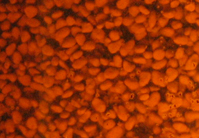How it works
Expanded bed technology can be used for a wide variety of biological processes, including water and wastewater treatment, fermentation and biocatalysis.
Our processes use microbes naturally immobilized on tiny particles of porous carbon. The small size of these particles provides an enormous surface area for the attached cells, typically 1,800 m2 per m3 of expanded bed. This results in a high biomass concentration, an intensified process and a compact plant. Typically, we can achieve 30-40 kg biomass per m3 of expanded bed, which is at least 10-times the concentration that can be achieved with continuous processes using suspended cells. The beds are expanded by the upward flow of liquid past the particles, which imparts a drag force that counteracts gravity and fluidizes (suspends) them. Attachment of cells to the particles leads to the formation of a biofilm, thus producing particulate biofilms. This immobilised biomass is retained in the process as the liquid flows through, unlike conventional suspension cultures which would be washed out at the flow rate required for bioparticle fluidization. It is this natural immobilization of cells in our processes that make them so efficient and productive.
In our aerobic processes, we recirculate the liquid via a counter-current bubble-contact column. This device is highly efficient and results in a doubling of oxygen transfer efficiency compared to conventional co-current systems. Furthermore, this efficiency is achieved without the need for expensive diffusers. Not only does our system halve the energy consumption for aeration but the air inlet arrangement is simple and cheap.
For most aerobic wastewater treatment processes, the energy consumed for aeration is 60-65% of the total. Therefore, by doubling the oxygen transfer efficiency, we can reduce the energy consumption by over 30% and make a significant contribution to reductions in operating cost and CO2 emissions.
For bioprocesses where the liquid bathing the cells needs to be replaced with a different liquid (e.g. biocatalysis), the change can be achieved very simply using our expanded bed technology. There is no need for additional equipment to separate the cells because the liquid phase can be replaced whilst the bioparticles are suspended. This is a major advantage for applications such as biocatalysis, where the cells can be grown and immobilised using a nutrient medium that can be replaced with the substrate for conversion once the biomass is established.
Reference
Dempsey, M.J. (1994). Biofilms & fluidized bed fermentation. Int. Biodeterioration & Biodegradation 34: 237-244.
